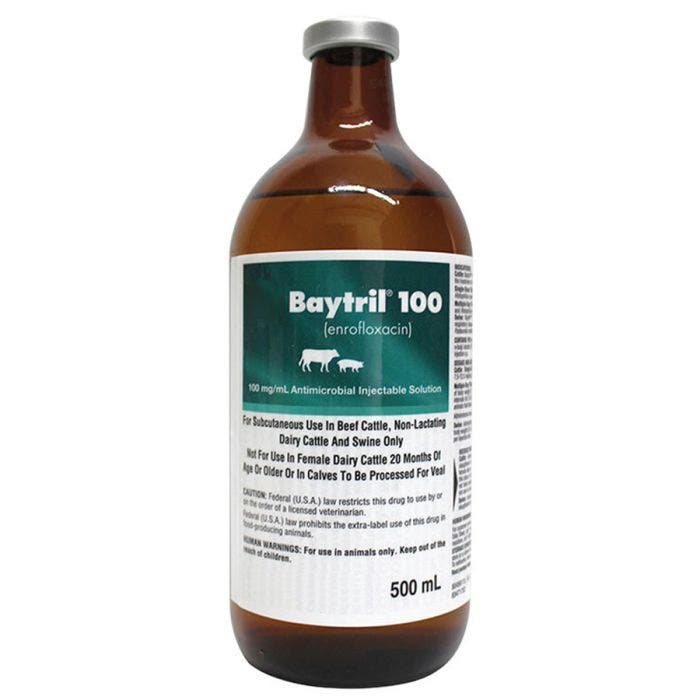Respiratory Health
Respiratory disease is the number one cause of nursery death and is endemic in many herds worldwide.1,2
Get Full Value from start to finish
Once signs of respiratory disease surface, it’s often too late to recover. Elanco offers vaccine, injectable, feed and water soluble solutions for industry-critical respiratory challenges.


Baytril® 100 - 100 mL
Respiratory disease occurrence and severity is affected by factors such as weaning, handling, temperature and ventilation. Baytril® 100 helps manage SRD and E. coli challenges that can be exacerbated by environmental stressors allowing producers to optimize full value from start to finish.
Baytril® 100 - 250 mL
Respiratory disease occurrence and severity are affected by factors such as weaning, handling, temperature and ventilation. Baytril® 100 helps manage SRD and E. coli challenges that can be exacerbated by environmental stressors allowing producers to optimize full value from start to finish.
Baytril® 100 - 500 mL
Respiratory disease occurrence and severity are affected by factors such as weaning, handling, temperature and ventilation. Baytril® 100 helps manage SRD and E. coli challenges that can be exacerbated by environmental stressors allowing producers to optimize full value from start to finish.


Denagard® LC- 1L
Denagard® LC treats swine pneumonia caused by Actinobacillus pleuropneumoniae (APP), a highly contagious disease often characterized by sudden onset, short clinical course, high morbidity and high mortality.

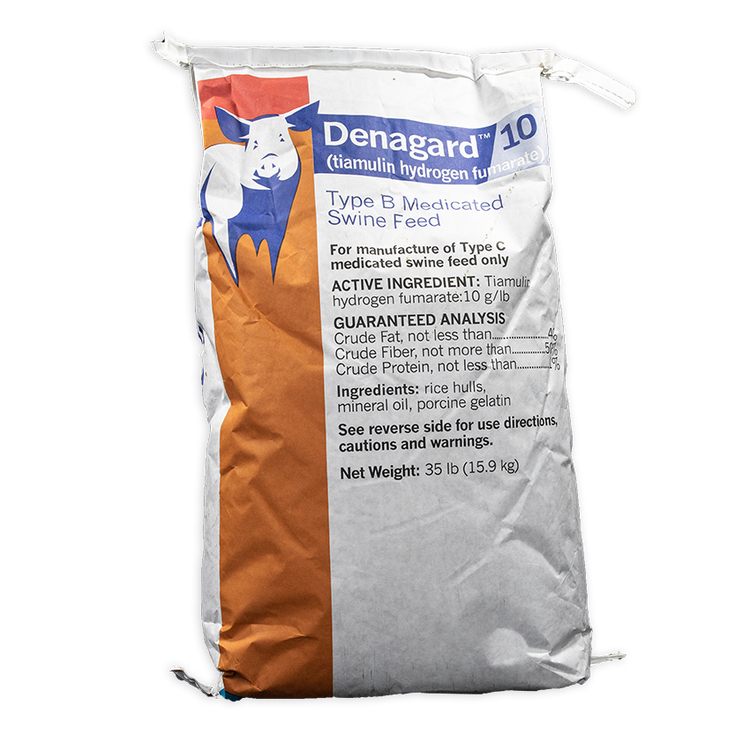
Denagard® 10 Premix
Denagard® 10 Premix effectively controls SD associated with Brachyspira hyodysenteriae, a highly contagious, difficult to control and slow immunity generating disease and ileitis associated with Lawsonia intracellularis, a leading enteric disease in the U.S.

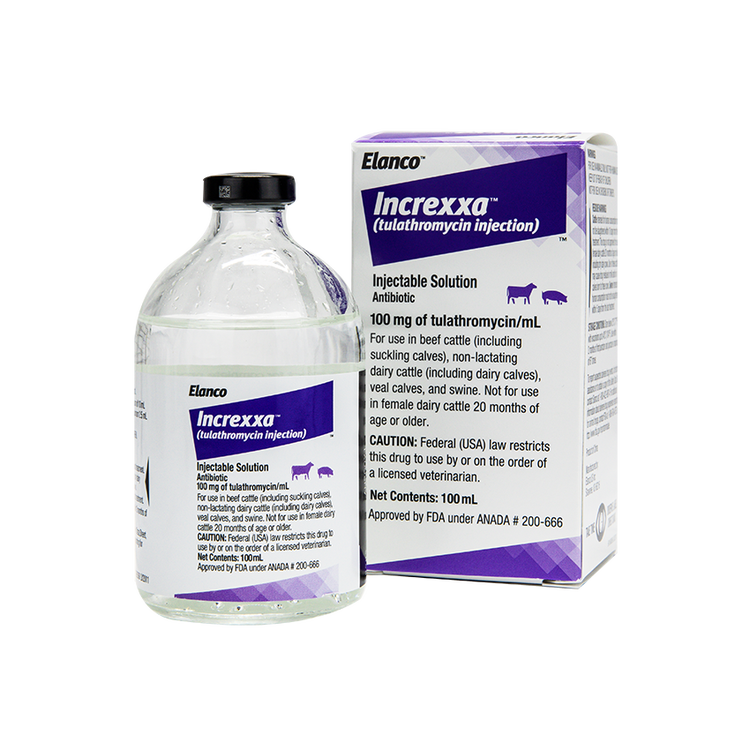
Increxxa 100 - 100mL
Balancing whole herd health with individual pig solutions. Combat SRD with IncrexxaTM’s (tulathromycin injection) industry-proven molecule

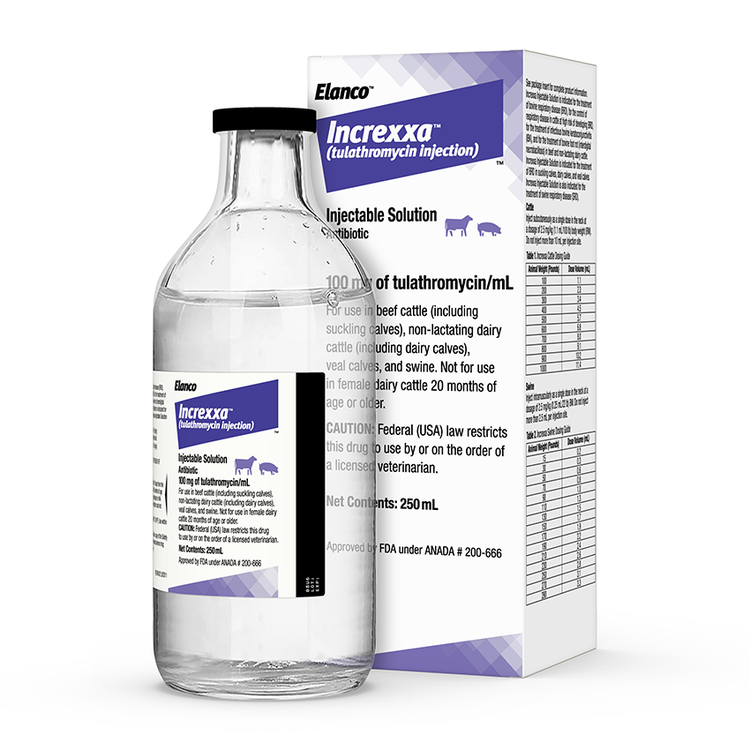
Increxxa 100 - 250mL
Balancing whole herd health with individual pig solutions. Combat SRD with IncrexxaTM’s (tulathromycin injection) industry-proven molecule.

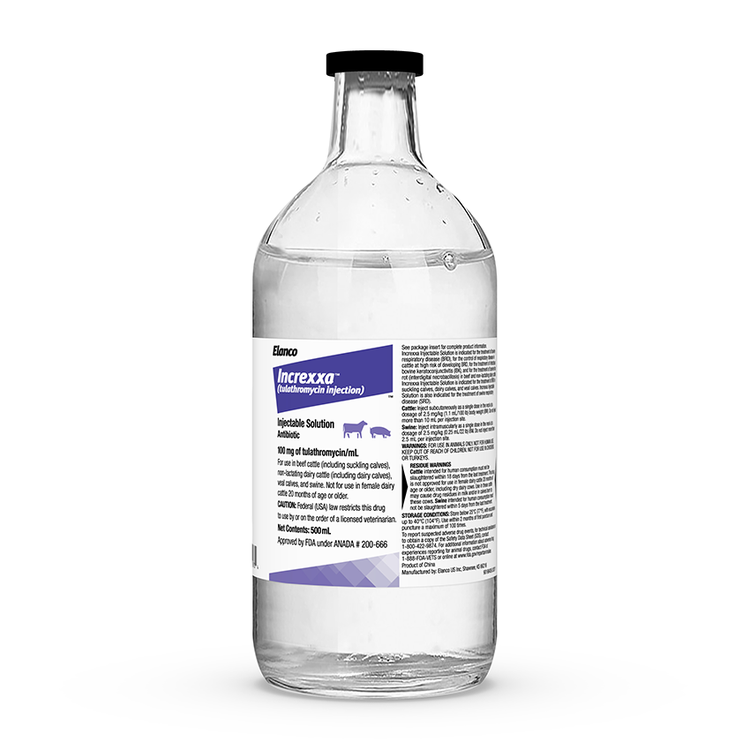
Increxxa 100 - 500mL
Balancing whole herd health with individual pig solutions. Combat SRD with IncrexxaTM’s (tulathromycin injection) industry-proven molecule.

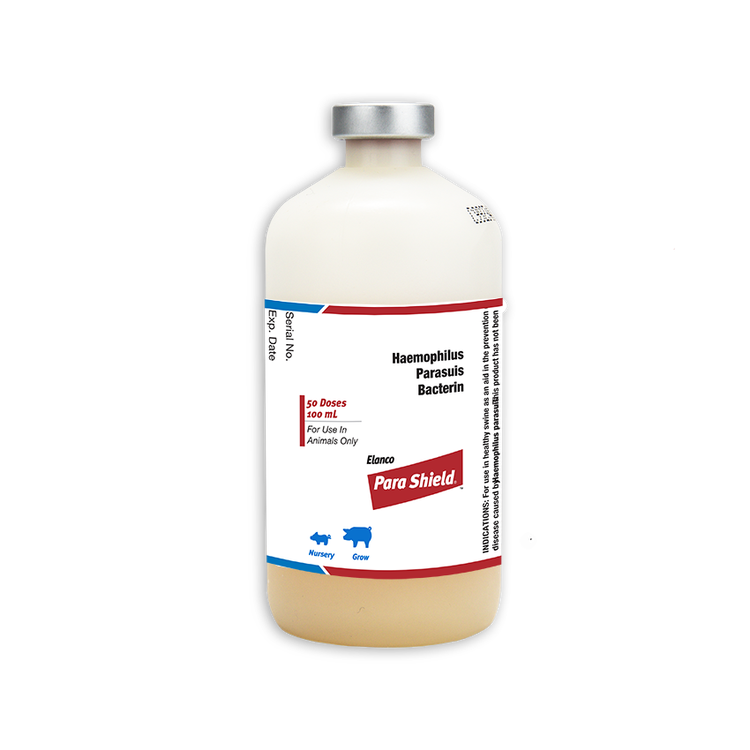
Para Shield® - 50 dose
Glasserella (Haemophilus) parasuis can develop suddenly, often resulting in death in less than two days, even in visibly healthy pigs. Stressors associated with weaning and the nursery environment significantly increase disease possibility.


Parvo Shield® - 10 dose
Consistent conception and farrowing rates for large litters can be impacted by disease challenges in prebreeding. Parvo Shield® L5E provides protection against parvovirus, five leptospirosis strains, and erysipelas to protect against reproductive loss.


Parvo Shield® - 50 dose
Consistent conception and farrowing rates for large litters can be impacted by disease challenges in prebreeding. Parvo Shield® L5E provides protection against parvovirus, five leptospirosis strains, and erysipelas to protect against reproductive loss.

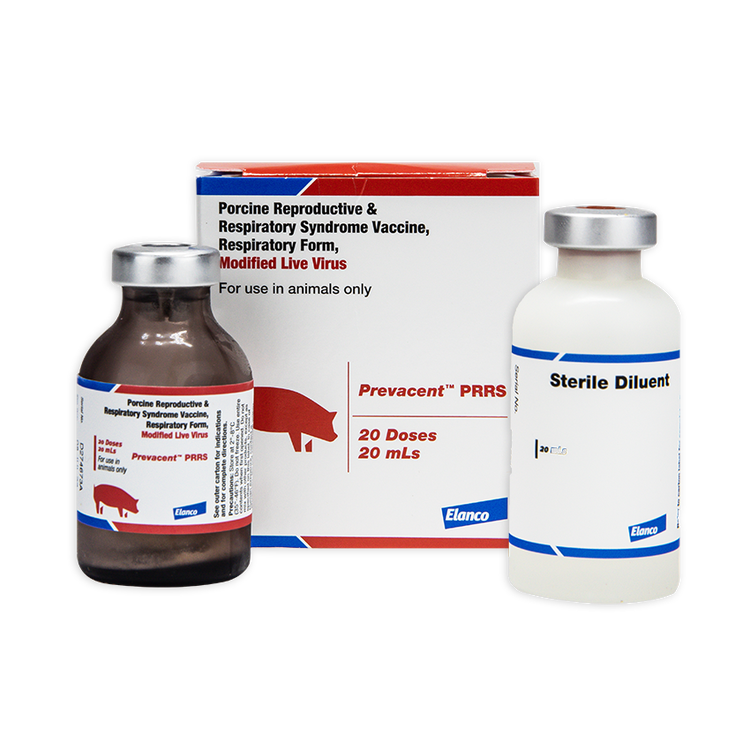
Prevacent® PRRS - 20 dose
Prevacent® PRRS has proven effective against the respiratory form of PRRS in healthy pigs at least 2 weeks of age or older and against reproductive disease when vaccinated 6 weeks prior to breeding.

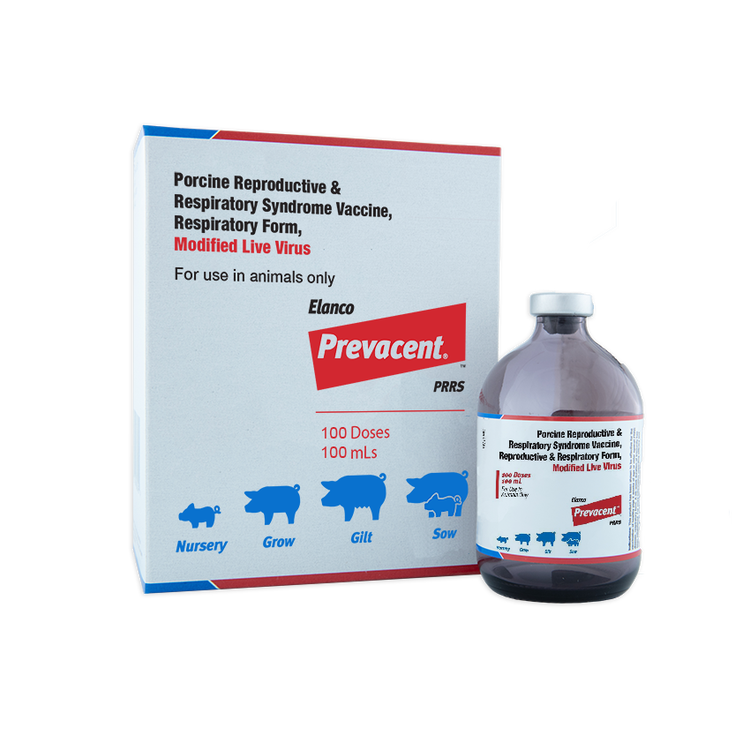
Prevacent® PRRS - 100 dose
Prevacent® PRRS has proven effective against the respiratory form of PRRS in healthy pigs at least 2 weeks of age or older and against reproductive disease when vaccinated 6 weeks prior to breeding.

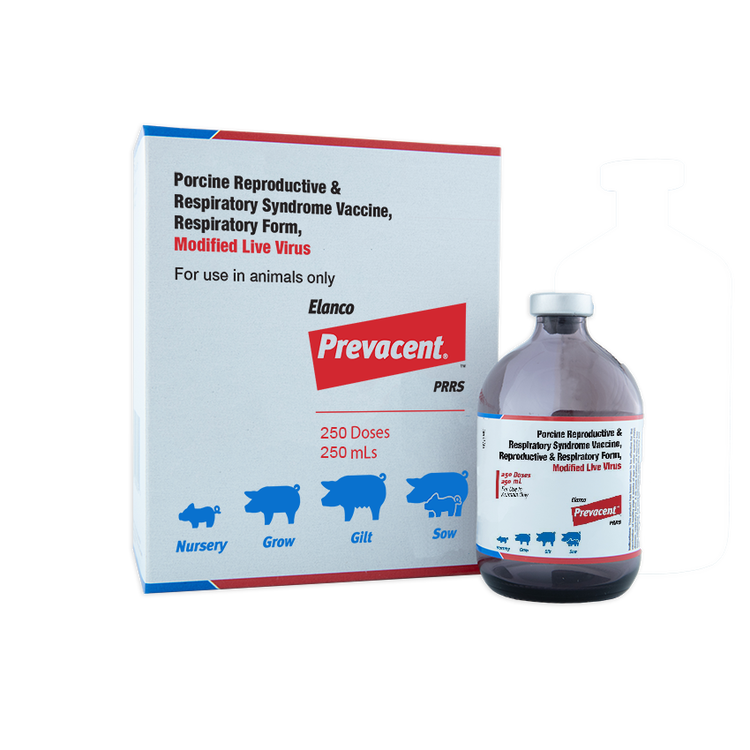
Prevacent® PRRS - 250 dose
Prevacent® PRRS has proven effective against the respiratory form of PRRS in healthy pigs at least 2 weeks of age or older and against reproductive disease when vaccinated 6 weeks prior to breeding.

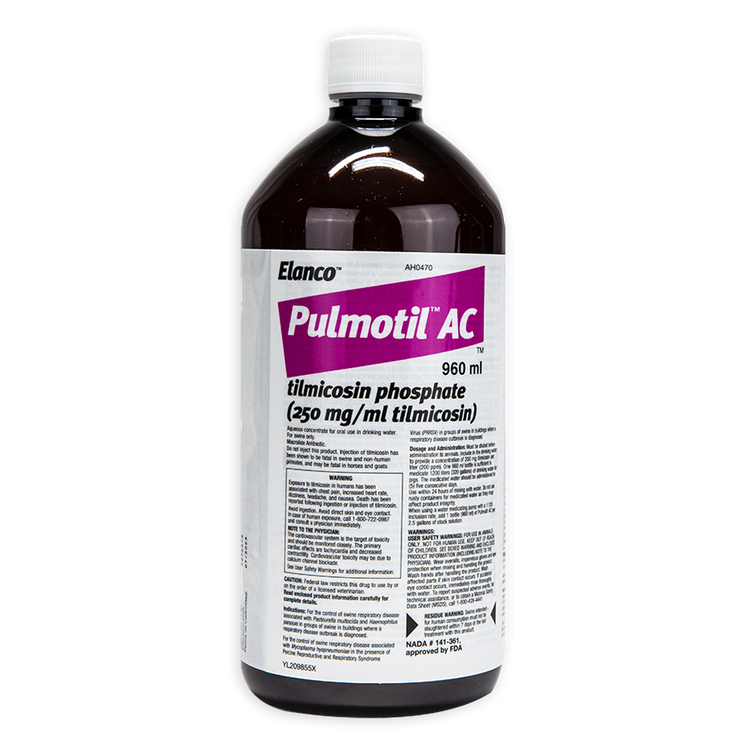
Pulmotil® AC (tilmicosin phosphate)
Pulmotil® AC quickly and effectively controls SRD associated with M. hyo in the presence of PRRS without the need to formulate new rations, or invest the additional time, individual documentation and repeated injection associated with individual pig injections.

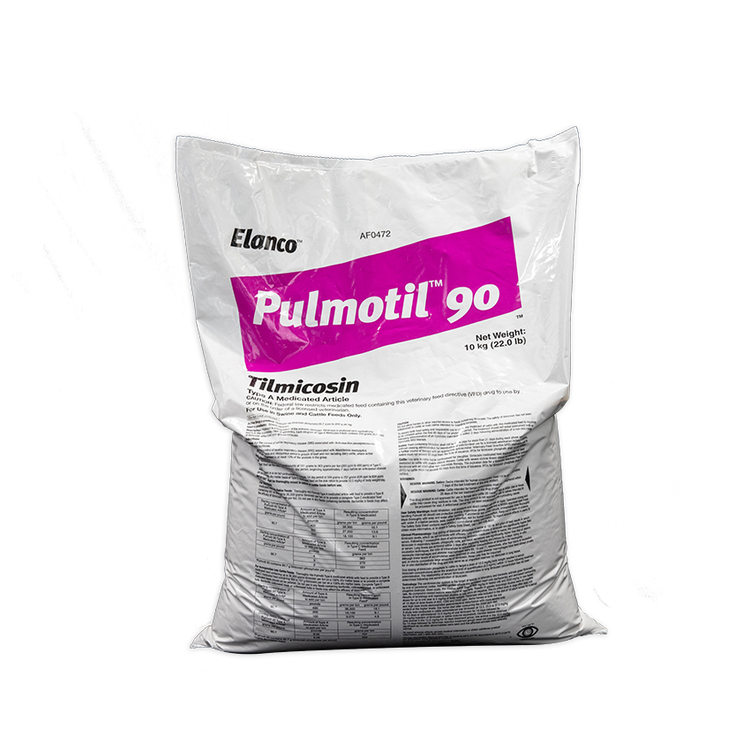
Pulmotil® Premix
Pulmotil® sets a foundation for health management by controlling SRD associated with Actinobacillus pleuropneumoniae (APP) and Pasteurella multocida. Feeding Pulmotil for the duration of lactation (21 days) to control respiratory disease in lactating sows decreases mortality in the farrowing and nursery phase.

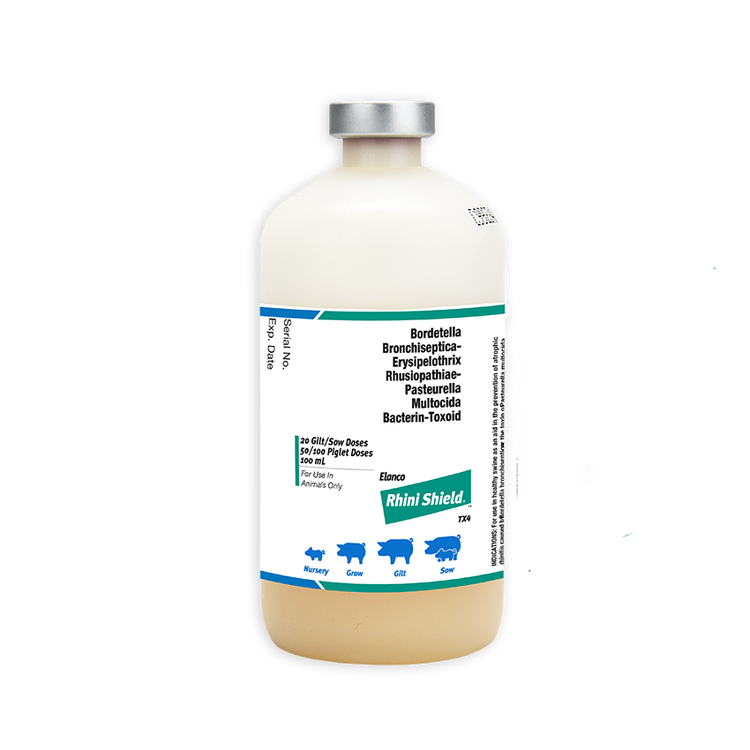
Rhini Shield® - 20 Gilt/Sow dose or 50/100 Piglet dose
Rhini Shield® aids healthy swine in the prevention of atrophic rhinitis caused by Bordetella bronchiseptica or the toxin of Pasteurella multocida Types A and D, erysipelas caused by Ersipelothrix rhusiopathiae and pneumonia caused by Pasteurella multocida Type A.
Tylan® (tylosin injection) 50 Injection - 100 mL
Tylan® Injection is a cost-effective multi-control solution trusted for more than 30 years.
Tylan® (tylosin injection) 200 Injection
Tylan® Injection is a cost-effective multi-control solution trusted for more than 30 years.
The label contains complete use information, including cautions and warnings. Always read, follow and understand the label and use directions.
Pulmotil® AC
IMPORTANT SAFETY INFORMATION:
Before using this product, it is important to read the entire product insert, including the boxed human warning.
WARNING: Exposure to tilmicosin in humans has been associated with chest pain, increased heart rate, dizziness, headache, and nausea. Death has been reported following ingestion or injection of tilmicosin. Avoid direct skin and eye contact. In case of human exposure, call 1-800-722-0987 and consult a physician immediately.
- Wear overalls, impervious gloves and eye protection when mixing and handling the product. Wash hands after handling the product. Wash affected parts if skin contact occurs. If accidental eye contact occurs, immediately rinse thoroughly with water.
CAUTION: Federal law restricts this drug to use by or on the order of a licensed veterinarian.
- For use only in swine. Not for injection. Injection of tilmicosin has been shown to be fatal in swine and non-human primates, and may be fatal in horses and goats.
- Swine intended for human consumption must not be slaughtered within 7 days of treatment.
- Always treat the fewest number of animals necessary to control a respiratory disease outbreak. Prescriptions shall not be refilled.
- Concurrent use of Pulmotil AC and another macrolide by any route, or use of another macrolide immediately following this use of Pulmotil AC is not advised.
- Ensure that pigs have continuous access to medicated water during the treatment period. Monitor pigs for signs of water refusal and dehydration while being treated.
INDICATIONS:
- For the control of swine respiratory disease associated with Pasteurella multocida and Haemophilus parasuis.
- For the control of swine respiratory disease associated with Mycoplasma hyopneumoniae in the presence of porcine reproductive and respiratory syndrome virus (PRRSv) in groups of swine in buildings where a respiratory disease outbreak is diagnosed.
DOSAGE AND ADMINISTRATION:
- Must be diluted before administration to animals.
- Include in the drinking water to provide a concentration of 200 mg tilmicosin per liter (200 ppm).
- One 960 ml bottle is sufficient to medicate 1200 liters (320 gallons) of drinking water for pigs.
- The medicated water should be administered for (5) five consecutive days.
- Use within 24 hours of mixing with water.
- Do not use rusty containers for medicated water as they may affect product integrity.
- When using a water medicating pump with a 1:128 inclusion rate, add 1 bottle (960 ml) of Pulmotil AC per 2.5 gallons of stock solution.
Baytril®
INDICATIONS:
- For the treatment and control of swine respiratory disease (SRD) associated with Actinobacillus pleuropneumoniae, Pasteurella multocida, Haemophilus parasuis, Streptococcus suis, Bordetella bronchiseptica, and Mycoplasma hyopneumoniae.
- For the control of colibacillosis in groups or pens of weaned pigs where colibacillosis associated with Escherichia coli has been diagnosed.
DOSAGE AND ADMINISTRATION:
- Administer, either by intramuscular or subcutaneous (behind the ear) injection, a single dose of 7.5 mg/kg of body weight (3.4 mL/100 lb). Administered dose volume should not exceed 5 mL per injection site.
- For the control of colibacillosis, administration should be initiated within the first 60 days post-weaning when clinical signs are present in at least 2% of the animals in the group. If no improvement is noted within 48 hours, the diagnosis should be reevaluated.
IMPORTANT SAFETY INFORMATION:
CAUTION: Federal (U.S.A.) law restricts this drug to use by or on the order of a licensed veterinarian. Federal (U.S.A.) law prohibits the extra-label use of this drug in food-producing animals. To assure responsible antimicrobial drug use, enrofloxacin should only be used as a second-line drug for colibacillosis in swine following consideration of other therapeutic options.
- Not for use in humans. Keep out of reach of children.
- Avoid contact with eyes. In case of contact, immediately flush eyes with copious amounts of water for 15 minutes.
- In case of dermal contact, wash skin with soap and water. Consult a physician if irritation persists following ocular or dermal exposures.
- Individuals with a history of hypersensitivity to quinolones should avoid this product. In humans, there is a risk of user photosensitization within a few hours after excessive exposure to quinolones. If excessive accidental exposure occurs, avoid direct sunlight.
Denagard® Premix
INDICATIONS:
- For control of swine dysentery associated with Brachyspira hyodysenteriae susceptible to Tiamulin.
- For treatment of swine dysentery associated with Brachyspira hyodysenteriae susceptible to Tiamulin.
- For control of porcine proliferative enteropathies (ileitis) associated with Lawsonia intracellularis susceptible to Tiamulin.
- + CTC: For control of swine dysentery associated with Brachyspira hyodysenteriae susceptible to Tiamulin and for treatment of swine bacterial enteritis caused by Escherichia coli and Salmonella choleraesuis sensitive to chlortetracycline and treatment of bacterial pneumonia caused by Pasteurella multocida sensitive to chlortetracycline.
DIRECTIONS FOR USE
For treatment of swine dysentery associated with Brachyspira hyodysenteriae susceptible to Tiamulin:
- Feed 200 g/ton for 14-days for treatment (7-day withdrawal).
For control of porcine proliferative enteropathies (ileitis) associated with Lawsonia intracellularis:
- Feed 35 g/ton for not less than 10 days (2-day withdrawal).
For control of swine dysentery associated with Brachyspira hyodysenteriae susceptible to Tiamulin:
- Feed 35 g/ton continuously as sole ration (2-day withdrawal).
Using Denagard alone does not require a Veterinary Feed Directive (VFD). Using Denagard + CTC does require a VFD.
- Feed 35 g/ton of Denagard + 400 g/ton (10 mg/lb body weight in daily divided doses) CTC for 14 days.
IMPORTANT SAFETY INFORMATION
- Keep out of reach of children.
- Avoid contact with skin. Direct contact with skin or mucous membranes may cause irritation.
CAUTION: Federal law restricts medicated feed containing this veterinary feed directive (VFD) drug to use by or on the order of a licensed veterinarian. Do not feed undiluted. Do not use in feeds for animals other than swine.
- The effects of Tiamulin on swine reproductive performance, pregnancy and lactation have not been determined.
- Swine being treated with Denagard (Tiamulin) should not have access to feeds containing polyether ionophores (e.g., lasalocid, monensin, narasin, salinomycin and semduramicin) as adverse reactions may occur. If signs of toxicity occur, discontinue use.
Denagard® LC
INDICATIONS:
- Treatment of swine dysentery associated with Brachyspira hyodysenteriae and swine pneumonia due to Actinobacillus pleuropneumoniae, susceptible to Tiamulin.
DIRECTIONS FOR USE:
- For treatment of swine dysentery, utilize Denagard LC in drinking water at 3.5 mg/lb for five consecutive days.
- For treatment of swine pneumonia, utilize Denagard LC in drinking water at 10.5 mg/lb for five consecutive days.
IMPORTANT SAFETY INFORMATION:
- Keep out of reach of children.
- Avoid direct contact with the skin. Direct contact with skin or mucous membranes may cause irritation.
- Withdraw medicated water 3 days before slaughter after treatment at 3.5 mg/lb and 7 days before slaughter following treatment at 10.5 mg/lb.
CAUTION: For use in drinking water of swine only - Not for use in humans.
- Prepare fresh medicated water daily. Use as the only source of drinking water for 5 days.
- The effects of Tiamulin on swine reproductive performance, pregnancy and lactation have not been determined.
- Swine being treated with Denagard (Tiamulin hydrogen fumarate) should not have access to feeds containing polyether ionophores (e.g. lasalocid, monensin, narasin, salinomycin and semduramicin) as adverse reactions may occur.
IncrexxaTM
INDICATIONS:
- Increxxa Injectable Solution is indicated for the treatment of swine respiratory disease (SRD) associated with Actinobacillus pleuropneumoniae, Pasteurella multocida, Bordetella bronchiseptica, Haemophilus parasuis, and Mycoplasma hyopneumoniae; and for the control of SRD associated with Actinobacillus pleuropneumoniae, Pasteurella multocida, and Mycoplasma hyopneumoniae in groups of pigs where SRD has been diagnosed.
DIRECTIONS FOR USE:
- Inject intramuscularly as a single dose in the neck at a dosage of 2.5 mg/kg (0.25 mL/22 lb) BW. Do not inject more than 2.5 mL per injection site.
IMPORTANT SAFETY INFORMATION:
- CAUTION: Federal (USA) law restricts this drug to use by or on the order of a licensed veterinarian.
- WARNINGS: FOR USE IN ANIMALS ONLY. NOT FOR HUMAN USE. KEEP OUT OF REACH OF CHILDREN. NOT FOR USE IN CHICKENS OR TURKEYS.
- Swine intended for human consumption must not be slaughtered within 5 days from the last treatment.
- The effects of Increxxa on porcine reproductive performance, pregnancy, and lactation have not been determined.
- Intramuscular injection can cause a transient local tissue reaction that may result in trim loss of edible tissue at slaughter.
- Store below 25°C (77°F), with excursions up to 40°C (104°F).
- 100 mL: Use within 2 months of first puncture and puncture a maximum of 67 times. If more than 67 punctures are anticipated, the use of multi-dosing equipment is recommended. When using a draw-off spike or needle with bore diameter larger than 16 gauge, discard any product remaining in the vial immediately after use.
- 250 mL and 500 mL: Use within 2 months of first puncture and puncture a maximum of 100 times. If more than 100 punctures are anticipated, the use of multi-dosing equipment is recommended. When using a draw-off spike or needle with bore diameter larger than 16 gauge, discard any product remaining in the vial immediately after use.
Para Shield®
INDICATIONS:
- This product has been shown to be effective for the vaccination of healthy swine against disease caused by Glaesserella parasuis.
- The duration of immunity for this product has not been established. For more information regarding efficacy and safety data, see productdata.aphis.usda.gov.
DIRECTIONS FOR USE:
- Shake well before using. Administer 2 mL intramuscularly at 3 to 4 weeks of age.
- Repeat in 2 to 3 weeks. Historically, annual revaccination has been recommended for this product.
- The need for this booster has not been established. For advice on revaccination frequency, in general or in the face of maternal antibody, stress or a disease exposure, consultation with a veterinarian is recommended.
IMPORTANT SAFETY INFORMATION
PRECAUTIONS:
- Store out of direct sunlight at 2° to 8° C (35° to 46° F).
- DO NOT FREEZE.
- Do not mix with other products except as specified on this label.
- This product has not been tested in pregnant animals. In case of human exposure, contact a physician.
- Use entire contents when first opened.
- Do not vaccinate within 21 days prior to slaughter.
- Anaphylactic reactions may occur. Symptomatic treatment: Epinephrine.
Prevacent® PRRS
INDICATIONS:
- This product has been shown to be effective for the vaccination of healthy pigs 2 weeks of age or older against PRRS respiratory disease; and against reproductive disease when vaccinated 6 weeks prior to breeding.
- The duration of immunity against respiratory disease is at least 26 weeks.
- The duration of immunity against reproductive disease has not been established. For more information regarding efficacy and safety data, go to productdata.aphis.usda.gov.
- Safety of this product has been demonstrated when sows or gilts are vaccinated prior to breeding or at any stage of pregnancy.
- Vaccine virus may be shed and transmitted to other populations of swine in contact with vaccinated swine.
- The duration of potential vaccine virus transmission may vary.
- Use of the vaccine in herds intended to remain PRRS virus seronegative is contraindicated.
- Introduction of vaccinated pigs into herds intended to remain PRRS virus seronegative is contraindicated.
DOSAGE AND ADMINISTRATION:
- Rehydrate with the accompanying sterile diluent.
- Shake well and draw back into the syringe the required amount.
- Administer 1 mL intramuscularly.
- The need for annual booster vaccinations has not been established for this product; consultation with a veterinarian is recommended.
IMPORTANT SAFETY INFORMATION
PRECAUTIONS:
- Store at 2°- 8°C (35°- 46°F). DO NOT FREEZE.
- Use entire contents when first opened.
- Do not mix with other products, except as specified on this label. In case of human exposure, contact a physician.
- Do not vaccinate within 21 days before slaughter.
- Inactivate unused contents before disposal.
- Anaphylactic reactions may occur. Symptomatic treatment: Epinephrine. Contains gentamicin as preservative.
Pulmotil® Premix
INDICATIONS:
- For the control of swine respiratory disease (SRD) associated with Actinobacillus pleuropneumoniae and Pasteurella multocida.
FEEDING DIRECTIONS:
- Tilmicosin is to be fed continuously at 181 grams to 363 per ton (200 ppm to 400 ppm) of Type C medicated feed as the sole ration for a 21 day period, beginning approximately 7 days before an anticipated disease outbreak.
IMPORTANT SAFETY INFORMATION:
CAUTION: Federal law restricts medicated feed containing this veterinary feed directive (VFD) drug to use by or on the order of a licensed veterinarian.
- Do not allow horses or other equines access to feeds containing tilmicosin.
- Feed containing tilmicosin shall not be fed to pigs for more than 21 days during each stage of production without ceasing administration for reevaluation of antimicrobial use by a licensed veterinarian before re-initiating a further course of therapy with an appropriate antimicrobial.
- Veterinary Feed Directive (VFD) expiration date for swine must not exceed 90 days from the time of issuance. VFDs for tilmicosin phosphate shall not be refilled.
WARNINGS: Swine intended for human consumption must not be slaughtered within 7 days of the last treatment of this drug product.
Rhini Shield®
INDICATIONS:
- Effective for vaccination of health swine, 7 days of age or older, against atrophic rhinitis caused by Bordetella bronchiseptica or the toxin Pasteurella multocida Types A and D, erysipelas caused Erysipelothrix rhusiopathiae, and pneumonia caused by Pasteurella multocida Type A.
- The duration of immunity for this product has not been established. For more information regarding efficacy and safety data, see productdata.aphis.usda.
IMPORTANT SAFETY INFORMATION
PRECAUTIONS:
- Store out of direct sunlight at 2° to 8° C (35° to 46° F).
- DO NOT FREEZE.
- Do not mix with other products, except as specified on this label.
- Use entire contents when first opened.
- Do not vaccinate within 21 days prior to slaughter.
- In case of human exposure, contact a physician.
- Anaphylactic reactions may occur. Symptomatic treatment: Epinephrine.
Tylan® Injection:
INDICATIONS:
- For the treatment of swine arthritis caused by Mycoplasma hyosynoviae; swine pneumonia caused by Pasteurella spp.; swine erysipelas caused by Erysipelothrix rhusiopathiae; swine dysentery associated with Treponema hyodysenteriae when followed by the appropriate medication in the drinking water and/or feed.
ADMINISTRATION AND DOSAGE:
- Inject intramuscularly 4 mg per pound of body weight (1 mL per 50 pounds) twice daily. Treatment should be continued 24 hours following remission of disease signs, not to exceed 3 days. Do not inject more than 5 mL per site.
IMPORTANT SAFETY INFORMATION:
CAUTION: Federal law restricts this drug to use by or on the order of a licensed veterinarian.
WARNING: NOT FOR HUMAN USE. KEEP OUT OF REACH OF CHILDREN.
- Adverse reactions, including shock and death may result from overdosage in baby pigs. Do not attempt injection into pigs weighing less than 25 pounds (0.5 mL) with the common syringe. It is recommended that Tylan 50 Injection be used in pigs weighing less than 25 pounds.
- Do not administer to horses or other equines. Injection of tylosin in equines has been fatal.
- Swine intended for human consumption must not be slaughtered within 14 days of the last use of this drug product.
- If tylosin medicated drinking water is used as a follow-up treatment for swine dysentery, the animal should thereafter receive feed containing 40 to 100 grams of tylosin per ton for 2 weeks to assure depletion of tissue residues.

